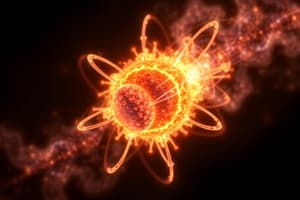Podcast
Questions and Answers
Which particles make up an atom?
Which particles make up an atom?
- Neutrons, electrons, and positrons
- Protons, neutrons, and photons
- Protons, neutrons, and electrons (correct)
- Protons, electrons, and positrons
What is the electrical charge of protons?
What is the electrical charge of protons?
- Neutral
- Positive (correct)
- Negative
- Variable
What is the electrical charge of electrons?
What is the electrical charge of electrons?
- Positive
- Neutral
- Variable
- Negative (correct)
What is the role of neutrons in an atom?
What is the role of neutrons in an atom?
How is nuclear energy released?
How is nuclear energy released?
Flashcards are hidden until you start studying
Study Notes
Atomic Structure
- An atom is composed of three main particles: protons, neutrons, and electrons.
Protons
- Protons are positively charged particles that reside in the nucleus (central part) of an atom.
- Protons have an electrical charge of +1 elementary charge.
Electrons
- Electrons are negatively charged particles that orbit around the nucleus of an atom.
- Electrons have an electrical charge of -1 elementary charge.
Neutrons
- Neutrons are particles with no electrical charge that reside in the nucleus of an atom along with protons.
- The role of neutrons is to stabilize the nucleus by balancing the positive charge of protons.
Nuclear Energy
- Nuclear energy is released through nuclear reactions, such as nuclear fission or fusion.
- These reactions involve the splitting or combining of atomic nuclei, resulting in a significant release of energy.
Studying That Suits You
Use AI to generate personalized quizzes and flashcards to suit your learning preferences.




